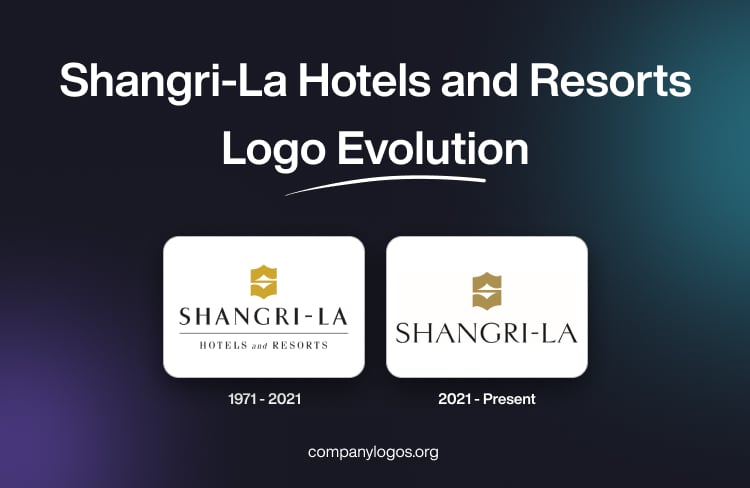
Shangri-La Hotels and Resorts is a popular chain of hotels with a presence in more than 75 countries. It was founded in 1971, with its first property opening in Singapore. From its inception, the brand has been closely tied to Asian heritage and emphasised sincerity, authenticity, and warm hospitality. The logo reflects these values with its distinctive “S” mark and a typeface that conveyed both elegance and tradition. The logo encapsulates the brand’s commitment to heartfelt service and luxury inspired by its Asian roots. The article delves into the evolution of the Shangri-La Hotels and Resorts over the years.
The Genesis of the Shangri-La Hotels and Resorts Logo (1971 – 2021)
The original logo of Shangri-La Hotels and Resorts featured the letter “S” in a stylised format. It was designed to evoke imagery inspired by Asian culture. It also aligned with the brand’s inspiration from the mythical paradise Shangri-la as described in Lost Horizon written by James Hilton. The letter “S” aimed to reflect hospitality, serenity, and Asian heritage.
The letter “S” was followed by the brand name “Shangri-La Hotels and Resorts” written in a typeface inspired by Asian calligraphy. In the logo, the word “Shangri-La” was written in a bigger size in black uppercase. Beneath the words were written “Hotels and Resorts” in a combination of uppercase and lowercase and separated by a thin line.

(2021 – Present)
In 2021, to mark its 50th anniversary, Shangri-La revised its logo. It was not merely a cosmetic update but a strategic move to reflect the brand’s journey with its guests and its vision for the future. The refreshed logo was designed to pay tribute to the brand’s roots. At the same time, it embraced a more contemporary and forward-looking identity.
In the 2021 logo iteration, the iconic “S” mark was retained to preserve the powerful brand equity that was built over five decades. The “S” symbol adopted a new golden colour to symbolise the warm glow of sunrise. The choice of colour signalled optimism, renewal, and the start of a new era for the brand. The typeface was modernised, and it drew inspiration from Asian calligraphy. This provided a fresh and contemporary look and reinforced the brand’s deep connection to its Asian heritage and traditions.
The refreshed logo has done away with the words “Hotels and Resorts”. This strategic decision reflects Shangri-La’s belief that its brand represents more than just physical locations. In fact, it embodies a feeling, an experience, and a source of joyful moments for guests.

The Elements of the Shangri-La Hotels and Resorts Logo
Font
The current Shangri-La Hotels and Resorts logo features a refined typeface that draws inspiration from Asian calligraphy. This modernised font was introduced to celebrate the 50th anniversary of the brand in 2021. The redesign aimed to create a stronger connection to the brand’s Asian heritage and traditions while also presenting a more contemporary, elegant, and sophisticated look. The calligraphic elements in the typeface evoke a sense of history and tradition and reinforce the roots and commitment of Shangri-La Hotels and Resorts to heartfelt Asian hospitality.
Colour
The signature “S” mark in the logo appears in a new golden colour. This colour is specifically chosen to evoke the warm glow of sunrise and to symbolise optimism, renewal, and the promise of new beginnings. The golden tone adds a sense of luxury and warmth to the brand’s identity and aligns with the brand’s philosophy of delivering joyful and uplifting experiences to guests. The refreshed colour palette is a key element in conveying the brand’s evolution while staying true to its core values.
The History of Shangri-La Hotels and Resorts
Shangri-La Hotels and Resorts was founded in 1971 by a Malaysian entrepreneur, Robert Kuok. Its first property in Singapore, Shangri-La Hotel, was opened on April 23, 1971, which set a new benchmark for luxury hospitality in Asia. The founder Kuok was inspired by the concept of “Shangri-La”, the mythical paradise described in James Hilton’s novel Lost Horizon. It symbolises peace, harmony, and exceptional beauty. His vision was to create a world-class hospitality brand that embodied the warmth, sincerity, and personalised service that are inherent in Asian traditions.
Building on the success of its Singapore flagship, the brand quickly expanded across Asia and beyond. In 1982, Shangri-La opened its first international property in Bangkok. The 1990s saw further growth, particularly with the opening of the first hotel in mainland China in Hangzhou in 1993. The brand thus tapped into one of the world’s fastest-growing travel markets.
In 1982, Shangri-La International Hotel Management Ltd was established to oversee the expanding portfolio of the brand. By 1997, Shangri-La Asia Limited was listed on the Hong Kong Stock Exchange. During that period, the hotel acquired the management company to further consolidate its leadership in luxury hospitality.
Today, Shangri-La Hotels and Resorts operates more than 100 hotels across 75 destinations and manages several brands, such as Shangri-La, Kerry Hotels, JEN, and Traders. The group’s portfolio has diversified to include not just hotels and resorts, but also office buildings, commercial real estate, and serviced apartments. Shangri-La is renowned for its heartfelt service, rich Asian heritage, and commitment to creating memorable guest experiences.
Shangri-La’s growth has been guided by its core philosophy – delivering transformative luxury experiences rooted in Asian hospitality, cultural authenticity, and attention to detail. The brand is also committed to sustainability and responsible tourism. The group continues to expand globally, with recent and upcoming openings in Phnom Penh, Mauritius, and Singapore’s Sentosa Island. Shangri-La’s ethos centres on creating personal moments of joy for guests of all ages and is supported by innovative facilities and world-class service.
Shangri-La Hotels and Resorts has evolved from a single hotel in Singapore to a leading global luxury hospitality group. It is renowned for its Asian heritage, heartfelt service, and ongoing commitment to excellence and innovation in the industry.
Interesting Facts About Shangri-La Hotels and Resorts
- The brand name “Shangri-La” comes from the fictional utopian paradise described in James Hilton’s 1933 novel Lost Horizon. The term symbolises peace, harmony, and beauty.
- Shangri-La Hotels and Resorts was founded in 1971 by Malaysian entrepreneur Robert Kuok, who envisioned a world-class hospitality brand rooted in Asian traditions.
- The first Shangri-La hotel opened in Singapore in 1971 and is renowned as a hidden urban oasis near Orchard Road. This flagship property also hosts the prestigious Shangri-La Dialogue, which is a major intergovernmental security conference.
- Shangri-La operates over 100 luxury hotels and resorts across more than 75 destinations worldwide. It is present in Africa, Asia, Europe, the Middle East, North America, and Oceania. However, it is not present in Latin America and the Caribbean.
- The group manages several brands catering to different market segments. These include Shangri-La, Traders Hotels, Kerry Hotels, Hotel Jen, and China World.
- Many Shangri-La properties are architectural icons. For example, Shangri-La at The Shard in London occupies Western Europe’s tallest building, and Shangri-La Paris is housed in the historic former residence of Prince Roland Bonaparte.
- Some Shangri-La hotels, like those in Toronto and Vancouver, combine luxury hospitality with high-end residential condominiums. They offer both hotel rooms and permanent residences in one building.
- Each Shangri-La property weaves local culture and art into its design and guest experience. For instance, Shangri-La Hotel Chengdu features gallery-worthy Chinese oil paintings, and the Toronto hotel preserved the historic Bishop’s Block as part of its development.
- Shangri-La Asia Limited, the group’s holding company, is incorporated in Bermuda and is listed on stock exchanges in Hong Kong, Singapore, and Malaysia.
- The Golden Circle loyalty programme, launched in 2002, rewards frequent guests and enhances customer experience across all Shangri-La properties.
- The brand is committed to sustainability and responsible tourism. It integrates eco-friendly practices and community initiatives into its operations.
- The company remains under the leadership of the Kuok family. Its current chairman is Kuok Hui-Kwong, daughter of founder Robert Kuok.
Finally
The logo of Shangri-La Hotels and Resorts is reflective of the brand’s journey from a single hotel in Singapore to a global leader in luxury hospitality. The refreshed logo, which was unveiled for the 50th anniversary, retains the essence of the brand. It signals a renewed commitment to innovation, guest experience, and the timeless values of Asian hospitality.